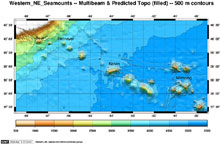
Western northeast seamounts shown with multibeam and predicted topography (filled), 500 m contours. Click image for larger view.
Mountains in the Sea 2004: Exploring the New England Seamount Chain
Les Watling, PhD
Chief Scientist
Benthic Ecologist
University of Maine
This is the second year of our Mountains in the Sea project to explore the New England seamount chain. In addition to the three seamounts visited last year—Manning, Kelvin, and Bear—we are adding Retriever Seamount. Located within the U.S. Exclusive Economic Zone (EEZ), Retriever Seamount, along with Bear Seamount, allows us to examine two seamounts under U.S. Fishery Management control. Our mission's objective is to document and try to understand the communities of octocorals (corals with eight featherlike tentacles) on the seamount chain.
Our team of investigators has a wide range of interests and expertise. We will focus on the following topics.
1.) Flow around the seamounts and its influence on octocoral distribution.
At the scale of the entire seamount, we will research octocoral distribution on both “upstream” and “downstream” sides of the seamount, using ocean-scale oceanographic studies as a guide to current direction. At the local seamount scale, we will map octocorals from the sides, up to and over the seamount rim. We will also recover small basalt (volcanic rock) blocks that were set out last year to catch octocoral larvae.
2.) Octocoral reproduction. We will collect the octocorals, then remove and fix polyps from different parts of the colony. Later, we will analyze these, using histological and electron microscopical techniques. In addition, any eggs we find will be counted and measured while the material is fresh. Since this year's cruise occurs in May, and last year’s was in August, we have the opportunity to determine whether there is a seasonal aspect to deep-sea octocoral reproduction.
It may seem strange to think about deep-sea corals reproducing seasonally, especially since we consider the deep-sea environment as unvarying. In fact, temperature, salinity, and oxygen levels do not vary with the seasons. There is, however, a seasonal signal that is observable in waters as deep as 4,000 m: the North Atlantic Ocean phytoplankton bloom each spring. About 10 years ago, researchers discovered that this intense bloom sinks, taking 30-60 days to reach the deep-sea floor. By May, some of this bloom should be present on the sides of the seamount; it may give the corals the extra energy they need to make eggs for spawning.
3.) Genetics. Team members will preserve small pieces of each octocoral collected for molecular genetic analysis. In the lab, the extracted DNA will help us to identify the coral species, as well as to understand the larger biogeographic distributions of some coral groups.
4.) Population biology of commensals. One problem researchers face in the study of deep-sea biology is the relative infrequency of sampling. Seamount environments are an extreme case: one can’t take any ship of opportunity, drop a piece of sampling gear over the side, and pull it over the mud. Seamounts have steep, rocky sides and must be sampled in situ. For animals living on octocorals, the issue is made more difficult, because octocoral species need to be identified while the gear is on the sea floor. Then, they must be sampled in a way that prevents the commensal species (organisms that benefit from a harmless relationship with another species) from escaping en route to the surface. We are especially interested in the brittle stars that often live in the upper parts of the corals and in a small group of polychaetes (worms) that live among the branches of primnoid and bamboo corals.
5.) Biogeography of deep-sea fishes at both seamount and landscape scale. Last year, we observed that seamount fishes exhibit a range of behaviors for finding prey. These foraging behaviors included active searching along the sea floor; station-keeping at particular habitats to ambush drifting prey; and drifting in the water column in a head-up or head-down mode to ambush swimming or drifting prey. This year, we will conduct a “behavioral census” of fishes, based on last year's observations. These data will help produce a refined picture of how seamount fishes divide the landscape, based on how they forage for prey.





















